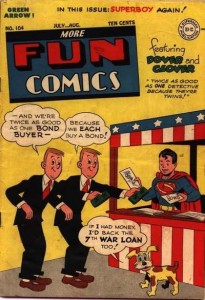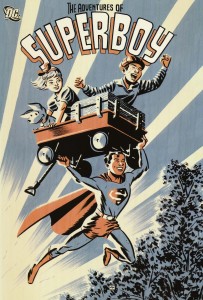Little did DC Comics know that the introduction of Robin the Boy Wonder in Detective Comics #38 (April 1940) would result in a flood of youthful Golden Age sidekicks. DC had a hit with Robin, and many of their popular heroes got sidekicks of their own. For some reason, DC’s most popular hero, Superman, never got a sidekick, but to capitalize on the success of their other youthful characters, the company launched Superboy. No, he was not a super powered companion to fight side by side with the Man of Steel, but a younger version of the Man himself, set in an earlier time. Curiously, Superboy did not debut as a back-up feature in Superman or Action Comics, but instead made his first appearance in the pages of More Fun Comics. More Fun Comics was best known at that time for The Sandman and Sandy (another youthful sidekick), but an abrupt change was made with issue #101 (January-February 1945), which featured The Green Arrow and Speedy on the cover.
The first Superboy story was written and drawn by Jerry Siegel and Joe Shuster, the creators of Superman. Interestingly, the majority of this story recounts the well known origin story, but shifts from the destruction of Krypton to a very young Clark Kent.
From an infant to a school age boy, we see Clark discover the strange powers that clearly set him apart from other kids his age. At the end of the origin story, we see young Clark pondering his powers, and ultimately deciding to adopt the identity and costume of Superboy so he can “do a lot of good”.
For the fans of Superboy most familiar with the character from the Silver Age of Comics and later, an expectation probably exists that the stories following the origin developed Clark and Superboy’s life in Smallville and the many characters that were showcased there over the years. These fans would probably also expect to see many early tales of Clark’s life with Ma and Pa Kent and how they helped him learn to use his powers for good as they steered him into becoming a superhero. Unfortunately, none of these aspects of Clark/Superboy’s life appear in these early adventures. In fact, during the Superboy stories in the 1940’s, the Kents are rarely shown and almost never mentioned. Likewise, Clark’s home is absent from most stories. The majority of the 1940’s Superboy stories feature Clark/Superboy interacting with Clark’s friends from town while they solve crimes, help each other and just generally “do a lot of good”. What town? Smallville is never mentioned, and we are only told that Clark lives in “a suburb of Metropolis”. In fact, he is often featured in Metropolis, and at times interacting with reporters from the Daily Planet, including a twenty-one year old Perry White in Adventure Comics #120 (“Perry White, Cub Reporter”, September 1947).
So, just how does Clark develop into Superboy in the 1940’s? From the start, we see Clark discover various aspects of his powers. For instance, in the second Superboy story from More Fun Comics #102 (March-April 1945) we see young Clark shot by a crook and in the next panel he is startled to realize that the bullet did not harm him (likely the very first time the boy of steel was struck by a bullet). In the same panel, he also discovers that he can “indefinitely” hold his breath under water.
One of the strangest aspects of the early Superboy adventures is the fact that Clark does not wear glasses and his hairstyle looks exactly like Superboy’s. In other words, they look exactly alike! Of course, no one ever remarks that they look alike or even suggests that Clark is Superboy. It was not until his seventh adventure that Clark began wearing glasses to change his appearance (More Fun Comics #107, “Ordeal on Wheels!”, January-February 1946).
So, just how old is this “Superboy” in the 1940’s adventures? It’s pretty plain to most readers that the Superboy in the 1950’s stories is a teenager in high school, but the Superboy in these early adventures looks a bit younger. In one of the earliest appearances of Ma and Pa Kent (other than their appearances in the origin stories as his adopting parents), we learn that Clark is a mere ten years old (“Happy Birthday!”, Adventure Comics #103, April 1946).
Superboy appeared in three different magazines during the 1940’s. His run in More Fun Comics ran through issue #107 (January-February 1946). His first cover appearance was More Fun Comics #104 (May 1946).
He then moved over to Adventure Comics starting with issue #103 (April 1946). His run in Adventure Comics continued into the 1970’s.
Superboy’s popularity in the second half of the 1940’s led to his own magazine. Superboy debuted in March-April 1949. Superboy ran until 1979.
Ironically, the popularity of Robin the Boy Wonder likely led to the creation of Superboy, but the success of Superboy led to Robin being given his own solo stories in the pages of Star Spangled Comics starting with issue #65 in February 1947. While the Robin stories have been reprinted in two DC Archives volumes, almost none of the early Superboy stories have been reprinted in the past. In 2001, DC published two Millennium Editions wherein they reprinted the entirety of More Fun Comics #101 and Superboy #1. Other than those two issues, the only way to read the earliest adventures was to obtain expensive original issues. That is, until this week when DC finally published a collection of the earliest Superboy stories from More Fun Comics and Adventure Comics in The Superboy Adventures. This 224 page book contains all of the Superboy stories from More Fun Comics #101 (January-February 1945) through #107 (January-February 1946) and Adventure Comics #103 (April 1946) through #121 (October 1947). It’s well worth the $39.99 cover price.
My friend Pat Curley at the Silver Age of Comic Books blog has published a lot of great information about the Silver Age Superboy, so check out his site for more interesting Superboy facts. He has also regularly pointed out where he’s found swipes of stories between the Golden Age and Silver Age, so I thought I would mention one here. While reading “Crimes on Delivery” from More Fun Comics #106 (November-December 1945), I couldn’t help but notice that it was a “slight” swipe of “The Grade A Crimes” from Batman #16 (April-May 1943). Both stories involve the use of milkmen to stage various crimes. While not a word-for-word swipe, the similarities are interesting. You can find “The Grade A Crimes” reprinted in The Dark Knight Archives, Volume 4 (2003).
If you are a fan of Superman, Superboy or the Golden Age of comic books, I highly recommend this new volume from DC Comics. I’m looking forward to volume 2!













Pingback: Litigation, Golden Age Style – Part 2 – Golden Age of Comic Books